Co-Occurrence of Regulated, Masked and Emerging Mycotoxins and Secondary Metabolites in Finished Feed and Maize—An Extensive Survey
Abstract
:1. Introduction
1.1. Regulated Toxins and Mycotoxins with Guidance Levels
1.2. Masked Mycotoxins
1.3. Emerging Toxins
1.4. Co-Occurrence
1.5. Regulations
1.6. Global Surveys
2. Results
3. Discussion
3.1. Finished Feed in Central Europe
3.2. Finished Feed in Global Regions and Countries
3.3. Yearly Median Concentrations 2012–2015
3.4. Maize and Maize Silage
3.5. Type A and B Trichothecenes
4. Conclusions
5. Materials and Methods
Author Contributions
Conflicts of Interest
Abbreviations
| 3-Ac-DON | 3-acetyl-deoxynivalenol |
| A & B | type A & B trichothecenes |
| AF | aflatoxin |
| AFB1 | aflatoxin B1 |
| AFLA | aflatoxins |
| BEA | beauvericin |
| CL | confidence level |
| DAS | diacetoxyscirpenol |
| DDGS | dried distillers grain with solubles |
| DON | deoxynivalenol |
| Elisa | enzyme linked immunosorbent assay |
| EU | European Union |
| FAO | Food and Agriculture Organization of the United Nations |
| FF | finished feed |
| FLD | fluorescence detector |
| FUM | fumonisins |
| FUS | toxins produced by Fusarium spp. |
| HPLC | high performance liquid chromatography |
| LC–MS/MS | liquid chromatography tandem mass spectrometry |
| LOD | limit of detection |
| M | maize |
| MON | moniliformine |
| MS | mass spectrometry |
| MSI | maize silage |
| NIV | nivalenol |
| OTA | ochratoxin A |
| REG | toxins and secondary metabolites (regulated or with guidance levels) |
| SBM | soybean meal |
| TLC | thin layer chromatography |
| ZEN | zearalenone |
References
- Smith, J.E.; Solomons, G.; Lewis, C.; Anderson, J.G. Role of mycotoxins in human and animal nutrition and health. Nat. Toxins 1995, 3, 187–192. [Google Scholar] [CrossRef] [PubMed]
- Wild, C.P.; Gong, Y.Y. Mycotoxins and human disease: A largely ignored global health issue. Carcinogenesis 2010, 31, 71–82. [Google Scholar] [CrossRef] [PubMed]
- Sweeney, M.J.; Dobson, A.D. Mycotoxin production by Aspergillus, Fusarium and Penicillium species. Int. J. Food Microbiol. 1998, 43, 141–158. [Google Scholar] [CrossRef]
- Rivas Casado, M.; Parsons, D.J.; Weightman, R.M.; Magan, N.; Origgi, S. Modelling a two-dimensional spatial distribution of mycotoxin concentration in bulk commodities to design effective and efficient sample selection strategies. Food Addit. Contam. 2009, 26, 1298–1305. [Google Scholar] [CrossRef] [Green Version]
- European Feed Manufacturers’ Federation (FEFAC). FEFAC Annual Report 2014–2015; FEFAC: Brussels, Belgium, 2015. [Google Scholar]
- Pinotti, L.; Ottoboni, M.; Giromini, C.; DellOrto, V.; Cheli, F. Mycotoxin contamination in the EU feed supply chain: A focus on cereal byproducts. Toxins 2016, 8, 45. [Google Scholar] [CrossRef] [PubMed]
- Centre, I.T. Trade Map—Trade Statistics for International Business Development. Available online: http://www.trademap.org/ (accessed on 28 November 2016).
- Hussein, H.S.; Brasel, J.M. Toxicity, metabolism, and impact of mycotoxins on humans and animals. Toxicology 2001, 167, 101–134. [Google Scholar] [CrossRef]
- Mathison, G.W. The Toxicology of Aflatoxins: Human Health, Veterinary, and Agricultural Significance; Academic Press, Inc.: New York, NY, USA, 2013; Volume 68, pp. 368–369. [Google Scholar]
- Carnaghan, R.B.A.; Hartley, R.D.; O’Kelly, J. Toxicity and fluorescence properties of the aflatoxins. Nature 1963, 4911, 1101. [Google Scholar] [CrossRef]
- Kumar, V.; Basu, M.S.; Rajendran, T.P. Mycotoxin research and mycoflora in some commercially important agricultural commodities. Crop Prot. 2008, 27, 891–905. [Google Scholar] [CrossRef]
- Langseth, W.; Rundberget, T. The occurrence of HT-2 toxin and other trichothecenes in Norwegian cereals. Mycopathologia 1999, 147, 157–165. [Google Scholar] [CrossRef] [PubMed]
- Eriksen, G.S.; Pettersson, H. Toxicological evaluation of trichothecenes in animal feed. Anim. Feed Sci. Technol. 2004, 114, 205–239. [Google Scholar] [CrossRef]
- Pittet, A. Natural occurrence of mycotoxins in foods and feeds: An update review. Revue Med. Vet. 1998, 6, 479–492. [Google Scholar]
- Hochsteiner, W.; Schuh, M. Occurrence of the fusariotoxins deoxynivalenol and zearalenone in Austrian feedstuff in the period from 1995 to 1999. DTW Deutsche Tierärztliche Wochenschrift 2001, 108, 19–23. [Google Scholar] [PubMed]
- Awad, W.; Ghareeb, K.; Böhm, J.; Zentek, J. The toxicological impacts of the Fusarium mycotoxin, deoxynivalenol, in poultry flocks with special reference to immunotoxicity. Toxins 2013, 5, 912–925. [Google Scholar] [CrossRef] [PubMed]
- Rafai, P.; Tuboly, S.; Bata, A.; Tilly, P.; Vanyi, A.; Papp, Z.; Jakab, L.; Tury, E. Effect of various levels of T-2 toxin in the immune system of growing pigs. Vet. Rec. 1995, 136, 511–514. [Google Scholar] [CrossRef] [PubMed]
- Meissonnier, G.M.; Laffitte, J.; Raymond, I.; Benoit, E.; Cossalter, A.M.; Pinton, P.; Bertin, G.; Oswald, I.P.; Galtier, P. Subclinical doses of T-2 toxin impair acquired immune response and liver cytochrome P450 in pigs. Toxicology 2008, 247, 46–54. [Google Scholar] [CrossRef] [PubMed]
- Kubena, L.F.; Edrington, T.S.; Harvey, R.B.; Buckley, S.A.; Phillips, T.D.; Rottinghaus, G.E.; Casper, H.H. Individual and combined effects of fumonisin B1 present in Fusarium moniliforme culture material and T-2 toxin or deoxynivalenol in broiler chicks. Poult. Sci. 1997, 76, 1239–1247. [Google Scholar] [CrossRef] [PubMed]
- Grenier, B.; Oswald, I. Mycotoxin co-contamination of food and feed: Meta-analysis of publications describing toxicological interactions. World Mycotoxin J. 2011, 4, 285–313. [Google Scholar] [CrossRef]
- Van der Fels-Klerx, H.; Stratakou, I. T-2 toxin and HT-2 toxin in grain and grain-based commodities in Europe: Occurrence, factors affecting occurrence, co-occurrence and toxicological effects. World Mycotoxin J. 2010, 3, 349–367. [Google Scholar] [CrossRef]
- Colvin, B.M.; Harrison, L.R. Fumonisin-induced pulmonary edema and hydrothorax in swine. Mycopathologia 1992, 117, 79–82. [Google Scholar] [CrossRef] [PubMed]
- Antonissen, G.; Van Immerseel, F.; Pasmans, F.; Ducatelle, R.; Janssens, G.P.J.; De Baere, S.; Mountzouris, K.C.; Su, S.; Wong, E.A.; De Meulenaer, B.; et al. Mycotoxins deoxynivalenol and fumonisins alter the extrinsic component of intestinal barrier in broiler chickens. J. Agric. Food Chem. 2015, 63, 10846–10855. [Google Scholar] [CrossRef] [PubMed]
- Pfohl-Leszkowicz, A.; Manderville, R.A. Ochratoxin A: An overview on toxicity and carcinogenicity in animals and humans. Mol. Nutr. Food Res. 2007, 51, 61–99. [Google Scholar] [CrossRef] [PubMed]
- Page, R.K.; Stewart, G.; Wyatt, R.; Bush, P.; Fletcher, O.J.; Brown, J. Influence of low levels of ochratoxin A on egg production, egg-shell stains, and serum uric-acid levels in Leghorn-type hens. Avian Dis. 1980, 24, 777–780. [Google Scholar] [CrossRef] [PubMed]
- Duarte, S.C.; Lino, C.M.; Pena, A. Ochratoxin A in feed of food-producing animals: An undesirable mycotoxin with health and performance effects. Vet. Microbiol. 2011, 154, 1–13. [Google Scholar] [CrossRef] [PubMed]
- Casteel, S.W.; Turk, J.R.; Cowart, R.P.; Rottinghaus, G.E. Chronic toxicity of fumonisin in weanling pigs. J. Vet. Diagn. Investig. 1993, 5, 413–417. [Google Scholar] [CrossRef]
- Zinedine, A.; Soriano, J.M.; Moltó, J.C.; Mañes, J. Review on the toxicity, occurrence, metabolism, detoxification, regulations and intake of zearalenone: An oestrogenic mycotoxin. Food Chem. Toxicol. 2007, 45, 1–18. [Google Scholar] [CrossRef] [PubMed]
- Rychlik, M.; Humpf, H.U.; Marko, D.; Dänicke, S.; Mally, A.; Berthiller, F.; Klaffke, H.; Lorenz, N. Proposal of a comprehensive definition of modified and other forms of mycotoxins including masked mycotoxins. Mycotoxin Res. 2014, 30, 197–205. [Google Scholar] [CrossRef] [PubMed]
- Gareis, M.; Bauer, J.; Thiem, J.; Plank, G.; Grabley, S.; Gedek, B. Cleavage of zearalenone-glycoside, a masked mycotoxin, during digestion in swine. J. Vet. Med. Ser. B 1990, 37, 236–240. [Google Scholar] [CrossRef]
- Berthiller, F.; Crews, C.; Dall’Asta, C.; Saeger, S.D.; Haesaert, G.; Karlovsky, P.; Oswald, I.P.; Seefelder, W.; Speijers, G.; Stroka, J. Masked mycotoxins: A review. Mol. Nutr. Food Res. 2013, 57, 165–186. [Google Scholar] [CrossRef] [PubMed] [Green Version]
- Berthiller, F.; Dall’Asta, C.; Schuhmacher, R.; Lemmens, M.; Adam, G.; Krska, R. Masked mycotoxins: Determination of a deoxynivalenol glucoside in artificially and naturally contaminated wheat by liquid chromatography-tandem mass spectrometry. J. Agric. Food Chem. 2005, 53, 3421–3425. [Google Scholar] [CrossRef] [PubMed]
- Lancova, K.; Hajslova, J.; Poustka, J.; Krplova, A.; Zachariasova, M.; Dostálek, P.; Sachambula, L. Transfer of Fusarium mycotoxins and masked deoxynivalenol (deoxynivalenol-3-glucoside) from field barley through malt to beer. Food Addit. Contam. 2008, 25, 732–744. [Google Scholar] [CrossRef] [PubMed]
- Dall’Erta, A.; Cirlini, M.; Dall’Asta, M.; Del Rio, D.; Galaverna, G.; Dall’Asta, C. Masked mycotoxins are efficiently hydrolyzed by human colonic microbiota releasing their aglycones. Chem. Res. Toxicol. 2013, 26, 305–312. [Google Scholar] [CrossRef] [PubMed]
- Plasencia, J.; Mirocha, C.J. Isolation and characterization of zearalenone sulfate produced by Fusarium spp. Appl. Environ. Microbiol. 1991, 57, 146–150. [Google Scholar] [PubMed]
- Krska, R. How does climate change impact on the occurrence and the determination of natural toxins. In Proceedings of the 7th International Symposium on Recent Advances in Food Analysis, Prague, Czech, 3–6 November 2015.
- Vaclavikova, M.; Malachova, A.; Veprikova, Z.; Dzuman, Z.; Zachariasova, M.; Hajslova, J. ‘Emerging’ mycotoxins in cereals processing chains: Changes of enniatins during beer and bread making. Food Chem. 2013, 136, 750–757. [Google Scholar] [CrossRef] [PubMed]
- Jestoi, M. Emerging Fusarium-mycotoxins fusaproliferin, beauvericin, enniatins, and moniliformin—A review. Crit. Rev. Food Sci. Nutr. 2008, 48, 21–49. [Google Scholar] [CrossRef] [PubMed]
- Serrano, A.; Font, G.; Ruiz, M.; Ferrer, E. Co-occurrence and risk assessment of mycotoxins in food and diet from Mediterranean area. Food Chem. 2012, 135, 423–429. [Google Scholar] [CrossRef] [PubMed]
- Streit, E.; Schatzmayr, G.; Tassis, P.; Tzika, E.; Marin, D.; Taranu, I.; Tabuc, C.; Nicolau, A.; Aprodu, I.; Puel, O. Current situation of mycotoxin contamination and co-occurrence in animal feed—Focus on Europe. Toxins 2012, 4, 788–809. [Google Scholar] [CrossRef] [PubMed]
- Streit, E.; Schwab, C.; Sulyok, M.; Naehrer, K.; Krska, R.; Schatzmayr, G. Multi-mycotoxin screening reveals the occurrence of 139 different secondary metabolites in feed and feed ingredients. Toxins 2013, 5, 504–523. [Google Scholar] [CrossRef] [PubMed]
- Malachova, A.; Dzuman, Z.; Veprikova, Z.; Vaclavikova, M.; Zachariasova, M.; Hajslova, J. Deoxynivalenol, deoxynivalenol-3-glucoside, and enniatins: The major mycotoxins found in cereal-based products on the Czech market. J. Agric. Food Chem. 2011, 59, 12990–12997. [Google Scholar] [CrossRef] [PubMed]
- Berthiller, F.; Schuhmacher, R.; Adam, G.; Krska, R. Formation, determination and significance of masked and other conjugated mycotoxins. Anal. Bioanal. Chem. 2009, 395, 1243–1252. [Google Scholar] [CrossRef] [PubMed]
- D’Mello, J.; Placinta, C.; Macdonald, A. Fusarium mycotoxins: a review of global implications for animal health, welfare and productivity. Anim. Feed Sci. Technol. 1999, 80, 183–205. [Google Scholar] [CrossRef]
- Harvey, R.; Edrington, T.; Kubena, L.; Elissalde, M.; Casper, H.; Rottinghaus, G.; Turk, J. Effects of dietary fumonisin B1-containing culture material, deoxynivalenol-contaminated wheat, or their combination on growing barrows. Am. J. Vet. Res. 1996, 57, 1790–1794. [Google Scholar] [PubMed]
- Grenier, B.; Bracarense, A.P.F.; Schwartz, H.E.; Lucioli, J.; Cossalter, A.M.; Moll, W.D.; Schatzmayr, G.; Oswald, I.P. Biotransformation approaches to alleviate the effects induced by fusarium mycotoxins in swine. J. Agric. Food Chem. 2013, 61, 6711–6719. [Google Scholar] [CrossRef] [PubMed] [Green Version]
- Antonissen, G.; Croubels, S.; Pasmans, F.; Ducatelle, R.; Eeckhaut, V.; Devreese, M.; Verlinden, M.; Haesebrouck, F.; Eeckhout, M.; De Saeger, S.; et al. Fumonisins affect the intestinal microbial homeostasis in broiler chickens, predisposing to necrotic enteritis. Vet. Res. 2015, 46, 98. [Google Scholar] [CrossRef] [PubMed] [Green Version]
- Tanaka, T.; Yamamoto, S.; Hasegawa, A.; Aoki, N.; Besling, J.R.; Sugiura, Y.; Ueno, Y. A survey of the natural occurrence of Fusarium mycotoxins, deoxynivalenol, nivalenol and zearalenone, in cereals harvested in the Netherlands. Mycopathologia 1990, 110, 19–22. [Google Scholar] [CrossRef] [PubMed]
- Placinta, C.; D’Mello, J.; Macdonald, A. A review of worldwide contamination of cereal grains and animal feed with Fusarium mycotoxins. Anim. Feed Sci. Technol. 1999, 78, 21–37. [Google Scholar] [CrossRef]
- Ali, N.; Sardjono; Yamashita, A.; Yoshizawa, T. Natural co-occurrence of aflatoxins and Fusarium mycotoxins (fumonisins, deoxynivalenol, nivalenol and zearalenone) in corn from Indonesia. Food Addit. Contam. 1998, 15, 377–384. [Google Scholar] [CrossRef] [PubMed]
- Commission, E. Commission Regulation (EU) No 574/2011 of 16 June 2011 amending Annex I to Directive 2002/32/EC of the European Parliament and of the Council as regards maximum levels for nitrite, melamine, Ambrosia spp. and carry-over of certain coccidiostats and histomonostats and consolidating Annexes I and II thereto. Off. J. Eur. Union 2011, L159, 7–24. [Google Scholar]
- Food and Agriculture Organization (FAO). Worldwide Regulations for Mycotoxins; Food and Agriculture Organization of the United Nations Food and Nutrition Paper; FAO: Rome, Italy, 1997. [Google Scholar]
- Commission, E. Commission Recommendation of 17 August 2006 on the presence of deoxynivalenol, zearalenone, ochratoxin A, T-2 and HT-2 and fumonisins in products intended for animal feeding. Off. J. Eur. Union 2006, L229, 7–9. [Google Scholar]
- Paterson, R.R.M.; Lima, N. How will climate change affect mycotoxins in food? Food Res. Int. 2010, 43, 1902–1914. [Google Scholar] [CrossRef] [Green Version]
- Magan, N.; Medina, A.; Aldred, D. Possible climate-change effects on mycotoxin contamination of food crops pre- and postharvest. Plant Pathol. 2011, 60, 150–163. [Google Scholar] [CrossRef]
- Murugesan, G.R.; Ledoux, D.R.; Naehrer, K.; Berthiller, F.; Applegate, T.J.; Grenier, B.; Phillips, T.D.; Schatzmayr, G. Prevalence and effects of mycotoxins on poultry health and performance, and recent development in mycotoxin counteracting strategies. Poult. Sci. 2015, 94, 1298–1315. [Google Scholar] [CrossRef] [PubMed]
- Streit, E.; Naehrer, K.; Rodrigues, I.; Schatzmayr, G. Mycotoxin occurrence in feed and feed raw materials worldwide: Long-term analysis with special focus on Europe and Asia. J. Sci. Food Agric. 2013, 93, 2892–2899. [Google Scholar] [CrossRef] [PubMed]
- Rodrigues, I.; Naehrer, K. A three-year survey on the worldwide occurrence of mycotoxins in feedstuffs and feed. Toxins 2012, 4, 663–675. [Google Scholar] [CrossRef] [PubMed]
- Sharman, M.; Gilbert, J.; Chelkowski, J. A survey of the occurrence of the mycotoxin moniliformin in cereal samples from sources worldwide. Food Addit. Contam. 1991, 8, 459–466. [Google Scholar] [CrossRef] [PubMed]
- Curtui, V.G.; Gareis, M.; Usleber, E.; Märtlbauer, E. Survey of Romanian slaughtered pigs for the occurrence of mycotoxins ochratoxins A and B, and zearalenone. Food Addit. Contam. 2001, 18, 730–738. [Google Scholar] [CrossRef] [PubMed]
- Resnik, S.; Neira, S.; Pacin, A.; Martinez, E.; Apro, N.; Latreite, S. A survey of the natural occurrence of aflatoxins and zearalenone in Argentine field maize: 1983–1994. Food Addit. Contam. 1996, 13, 115–120. [Google Scholar] [CrossRef] [PubMed]
- Schatzmayr, G.; Streit, E. Global occurrence of mycotoxins in the food and feed chain: Facts and figures. World Mycotoxin J. 2013, 6, 213–222. [Google Scholar] [CrossRef]
- Van Der Fels-Klerx, H.J.; Klemsdal, S.; Hietaniemi, V.; Lindblad, M.; Ioannou-Kakouri, E.; Van Asselt, E.D. Mycotoxin contamination of cereal grain commodities in relation to climate in North West Europe. Food Addit. Contam. A 2012, 29, 1581–1592. [Google Scholar] [CrossRef] [PubMed]
- Rodrigues, I.; Handl, J.; Binder, E.M. Mycotoxin occurrence in commodities, feeds and feed ingredients sourced in the Middle East and Africa. Food Addit. Contam. B 2011, 4, 168–179. [Google Scholar] [CrossRef] [PubMed]
- Vanheule, A.; Audenaert, K.; De Boevre, M.; Landschoot, S.; Bekaert, B.; Munaut, F.; Eeckhout, M.; Höfte, M.; De Saeger, S.; Haesaert, G. The compositional mosaic of Fusarium species and their mycotoxins in unprocessed cereals, food and feed products in Belgium. Int. J. Food Microbiol. 2014, 181, 28–36. [Google Scholar] [CrossRef] [PubMed]
- Han, R.W.; Zheng, N.; Wang, J.Q.; Zhen, Y.P.; Xu, X.M.; Li, S.L. Survey of aflatoxin in dairy cow feed and raw milk in China. Food Control 2013, 34, 35–39. [Google Scholar] [CrossRef]
- Van Asselt, E.D.; Azambuja, W.; Moretti, A.; Kastelein, P.; De Rijk, T.C.; Stratakou, I.; Van Der Fels-Klerx, H.J. A Dutch field survey on fungal infection and mycotoxin concentrations in maize. Food Addit. Contam. A 2012, 29, 1556–1565. [Google Scholar] [CrossRef] [PubMed]
- Anjum, M.A.; Khan, S.H.; Sahota, A.W.; Sardar, R. Assessment of aflatoxin B1 in commercial poultry feed and feed ingredients. J. Anim. Plant Sci. 2012, 22, 268–272. [Google Scholar]
- Zhang, Y.; Caupert, J. Survey of mycotoxins in US distiller’s dried grains with solubles from 2009 to 2011. J. Agric. Food Chem. 2012, 60, 539–543. [Google Scholar] [CrossRef] [PubMed]
- Martins, H.M.; Almeida, I.; Camacho, C.; Costa, J.M.; Bernardo, F. A survey on the occurrence of ochratoxin A in feeds for swine and laying hens. Mycotoxin Res. 2012, 28, 107–110. [Google Scholar] [CrossRef] [PubMed]
- Del Pilar Monge, M.; Magnoli, C.E.; Chiacchiera, S.M. Survey of Aspergillus and Fusarium species and their mycotoxins in raw materials and poultry feeds from Córdoba, Argentina. Mycotoxin Res. 2012, 28, 111–122. [Google Scholar] [CrossRef] [PubMed]
- Njobeh, P.B.; Dutton, M.F.; Åberg, A.T.; Haggblom, P. Estimation of multi-mycotoxin contamination in South African compound feeds. Toxins 2012, 4, 836–848. [Google Scholar] [CrossRef] [PubMed]
- Tabuc, C.; Taranu, I.; Calin, L. Survey of mould and mycotoxin contamination of cereals in South-Eastern Romania in 2008–2010. Archiva Zootechnica 2011, 14, 25. [Google Scholar]
- Skrbić, B.; Malachova, A.; Zivancev, J.; Veprikova, Z.; Hajslová, J. Fusarium mycotoxins in wheat samples harvested in Serbia: A preliminary survey. Food Control 2011, 22, 1261–1267. [Google Scholar] [CrossRef]
- Guan, S.; Gong, M.; Yin, Y.; Huang, R.; Ruan, Z.; Zhou, T.; Xie, M. Occurrence of mycotoxins in feeds and feed ingredients in China. J. Food Agric. Environ. 2011, 9, 163–167. [Google Scholar]
- Botana, L.M.; Sainz, M.J. Climate Change and Mycotoxins; Walter de Gruyter GmbH & Co KG: Berlin, Germany; Boston, MA, USA, 2015. [Google Scholar]
- McGill, R.; Tukey, J.W.; Larsen, W.A. Variations of box plots. Am. Stat. 1978, 32, 12–16. [Google Scholar]
- Tanaka, T.; Hasegawa, A.; Yamamoto, S.; Lee, U.S.; Sugiura, Y.; Ueno, Y. Worldwide contamination of cereals by the Fusarium mycotoxins nivalenol, deoxynivalenol, and zearalenone. 1. Survey of 19 countries. J. Agric. Food Chem. 1988, 36, 979–983. [Google Scholar] [CrossRef]
- Berthiller, F.; DallAsta, C.; Corradini, R.; Marchelli, R.; Sulyok, M.; Krska, R.; Adam, G.; Schuhmacher, R. Occurrence of deoxynivalenol and its 3-beta-D-glucoside in wheat and maize. Food Addit. Contam. 2009, 26, 507–511. [Google Scholar] [CrossRef] [PubMed]
- Pena, T.; Lara, P.; Castrodeza, C. Multiobjective stochastic programming for feed formulation. J. Oper. Res. Soc. 2009, 60, 1738–1748. [Google Scholar] [CrossRef]
- Van Egmond, H.P.; Schothorst, R.C.; Jonker, M.A. Regulations relating to mycotoxins in food. Anal. Bioanal. Chem. 2007, 389, 147–157. [Google Scholar] [CrossRef] [PubMed]
- Versilovskis, A.; Bartkevics, V.; Mickelsone, V. Sterigmatocystin presence in typical Latvian grains. Food Chem. 2008, 109, 243–248. [Google Scholar] [CrossRef] [PubMed]
- Kosiak, B.; Torp, M.; Skjerve, E.; Thrane, U. The prevalence and distribution of fusarium species in norwegian cereals: A Survey. Acta Agric. Scand. Sect. B Soil Plant Sci. 2003, 53, 168–176. [Google Scholar]
- Sydenham, E.W.; Thiel, P.G.; Marasas, W.F.; Shephard, G.S.; Van Schalkwyk, D.J.; Koch, K.R. Natural occurrence of some Fusarium mycotoxins in corn from low and high esophageal cancer prevalence areas of the Transkei, Southern Africa. J. Agric. Food Chem. 1990, 38, 1900–1903. [Google Scholar] [CrossRef]
- Kabak, B.; Dobson, A.D.; Var, I. Strategies to prevent mycotoxin contamination of food and animal feed: A review. Crit. Rev. Food Sci. Nutr. 2006, 46, 593–619. [Google Scholar] [CrossRef] [PubMed]
- Naehrer, K.; Kovalsky, P. The Biomin Mycotoxin Survey, Identifying the threats in 2013. Mycotoxins Science and Solutions. April 2014, pp. 2–7. Available online: http://www.biomin.net/uploads/tx_news/MAG_SciSol_Special_MTX_EN_0414.pdf (accessed on 5 December 2016).
- Malachová, A.; Sulyok, M.; Beltrán, E.; Berthiller, F.; Krska, R. Optimization and validation of a quantitative liquid chromatography–tandem mass spectrometric method covering 295 bacterial and fungal metabolites including all regulated mycotoxins in four model food matrices. J. Chromatogr. A 2014, 1362, 145–156. [Google Scholar] [CrossRef] [PubMed]
- Berendsen, B.; Meijer, T.; Wegh, R.; Mol, H.; Smyth, W.; Armstrong Hewitt, S.; van Ginkel, L.; Nielen, M. A critical assessment of the performance criteria in confirmatory analysis for veterinary drug residue analysis using mass spectrometric detection in selected reaction monitoring mode. Drug Test. Anal. 2016, 8, 477–490. [Google Scholar] [CrossRef] [PubMed]
- Pihlström, T. Method Validation and Quality Control Procedures for Pesticide Residues Analysis in Food and Feed; DG SANCO/12495/2011; European Commission Directorate-General for Health and Food Safety: Brussels, Belgium, 2011; pp. 1–41. [Google Scholar]

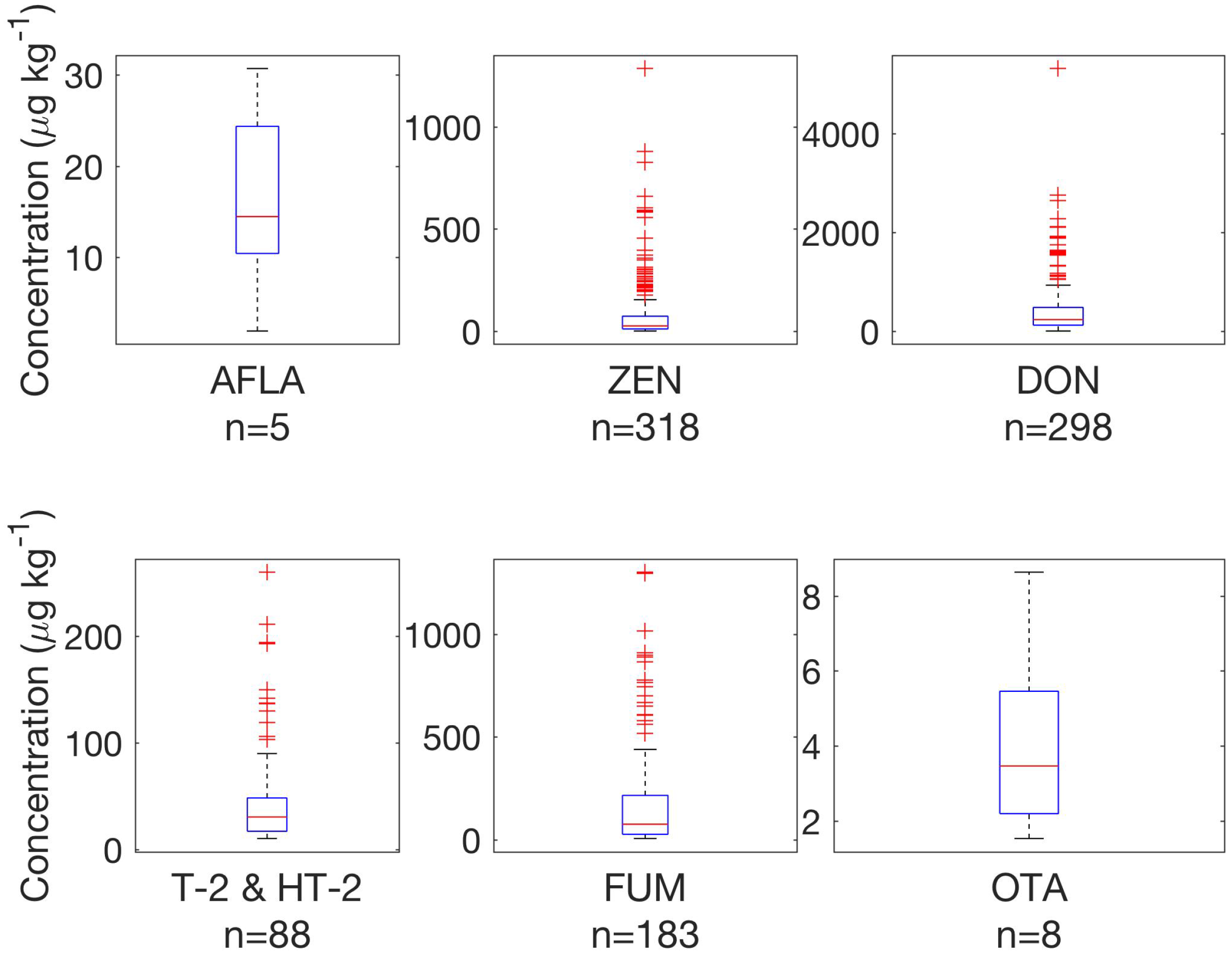
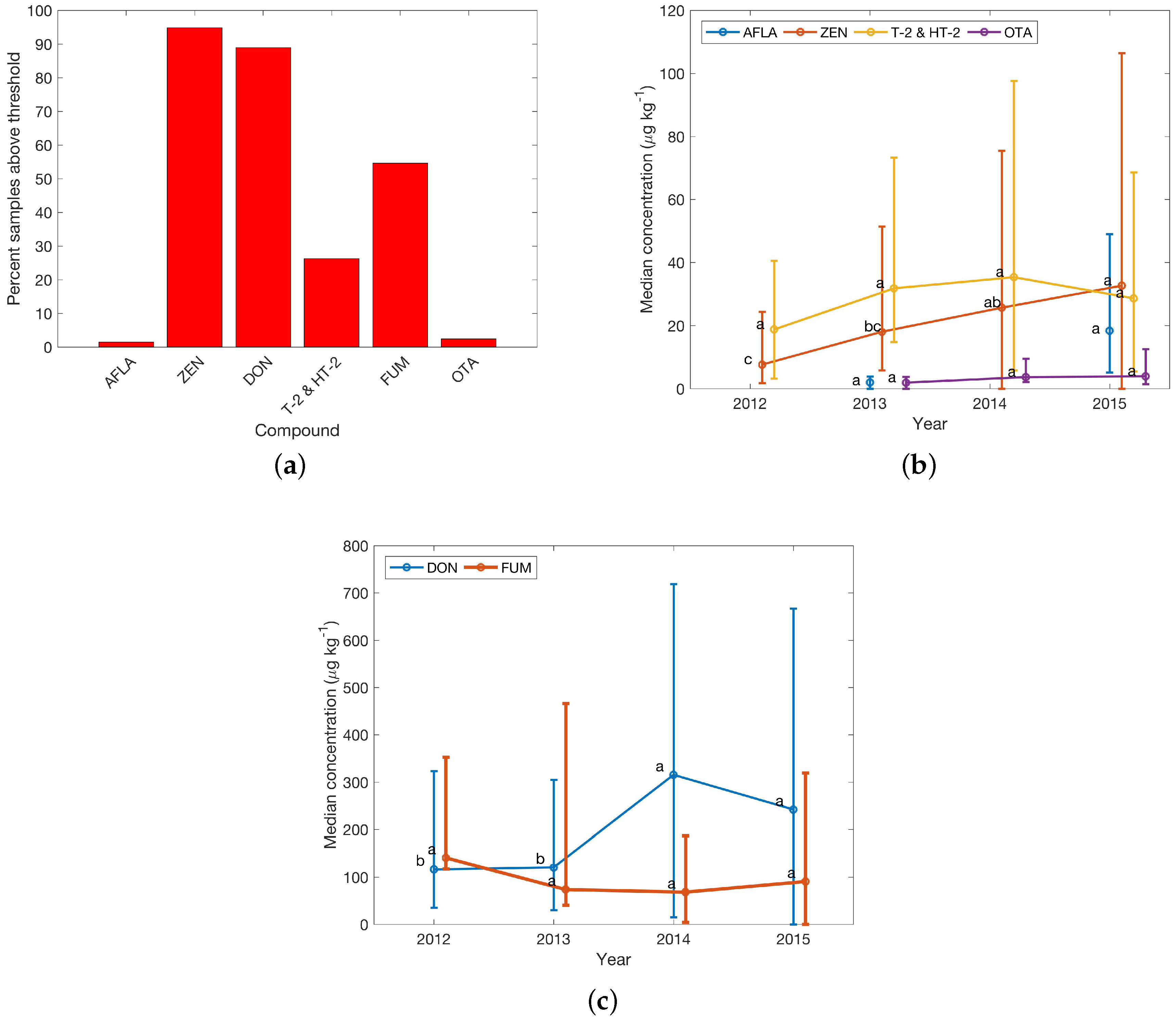
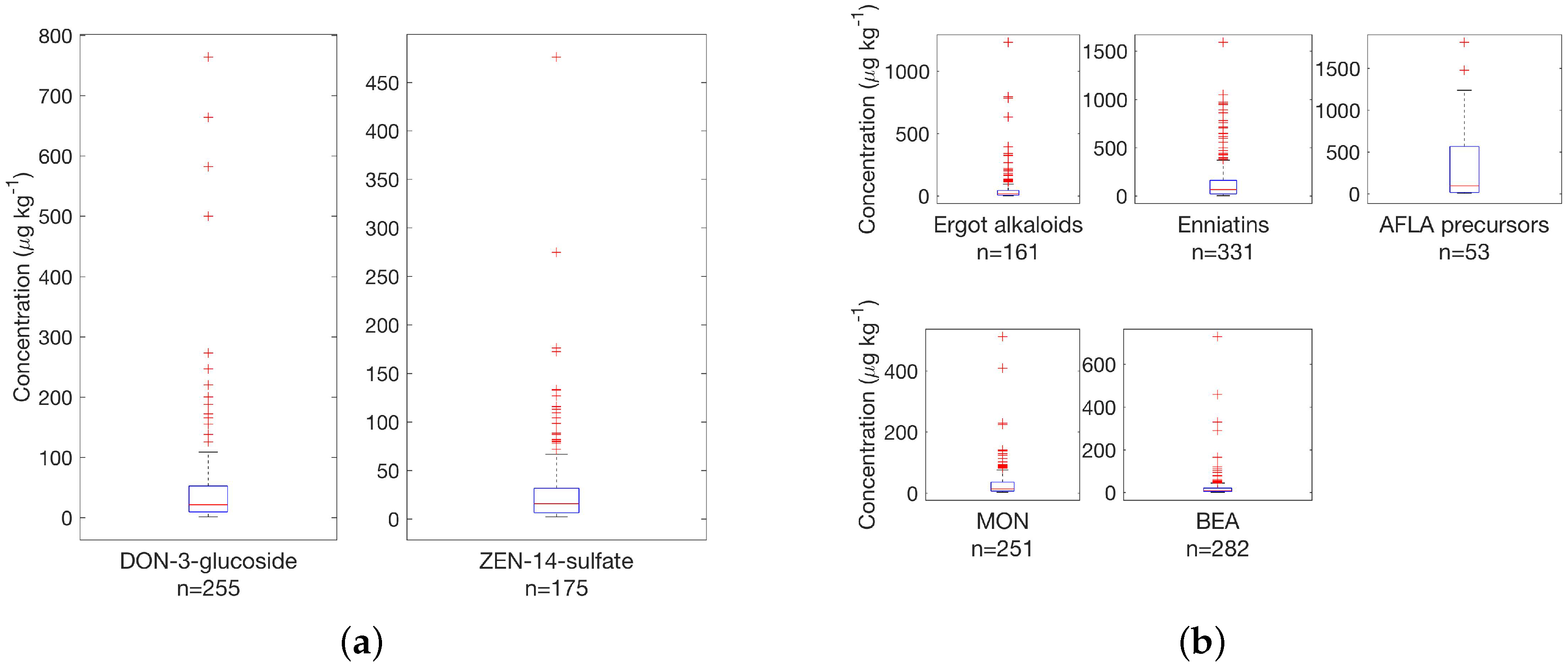
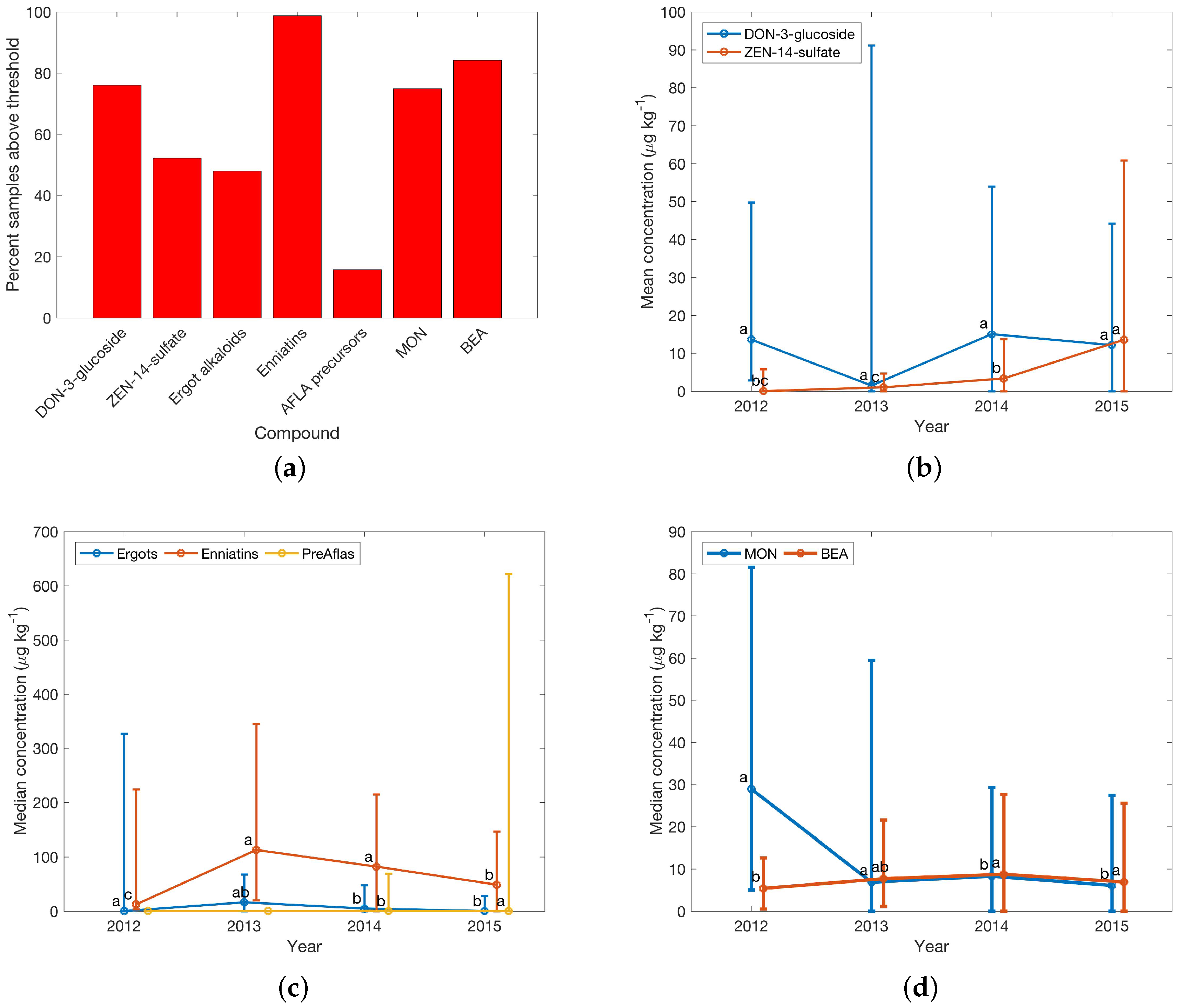
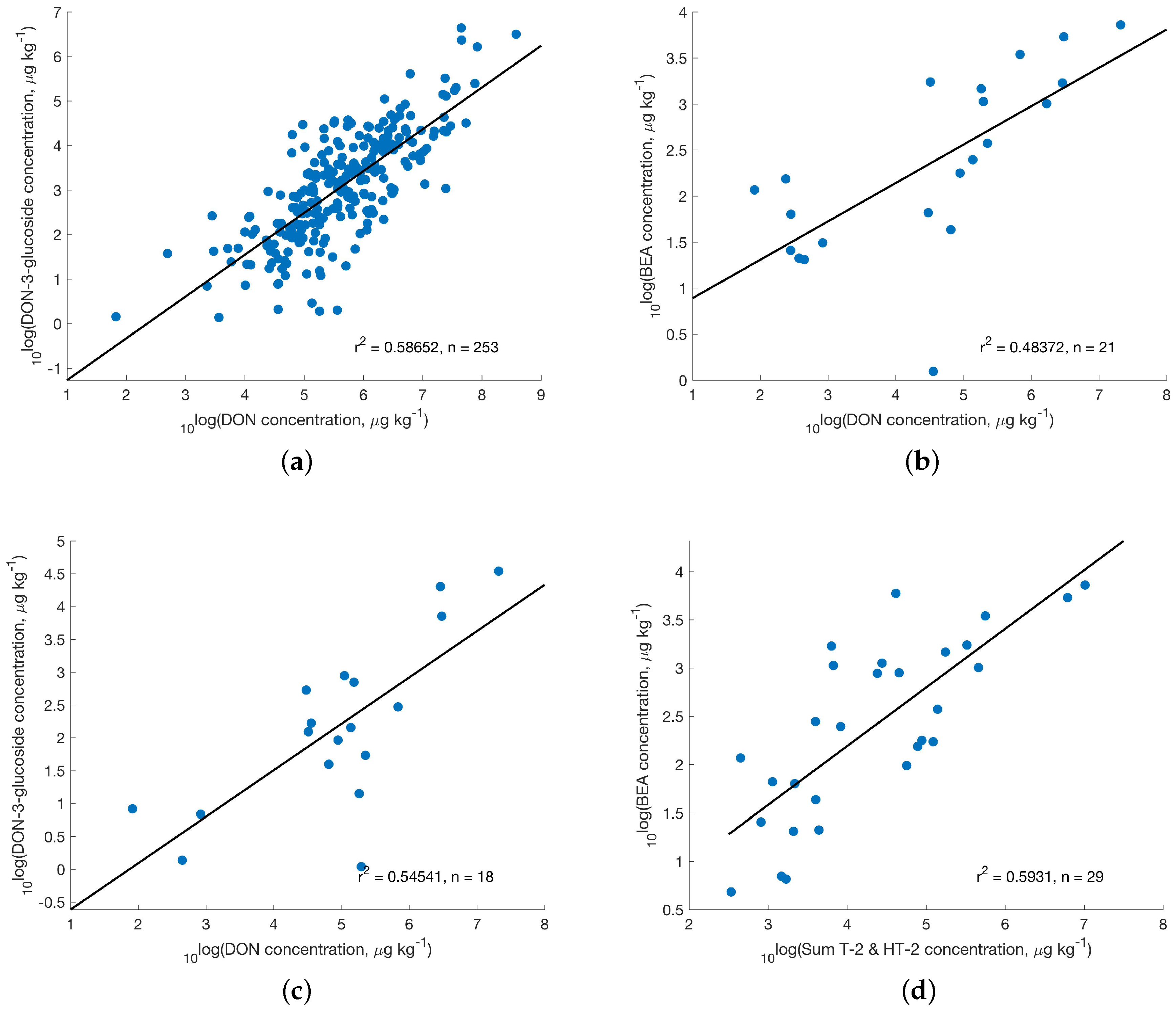
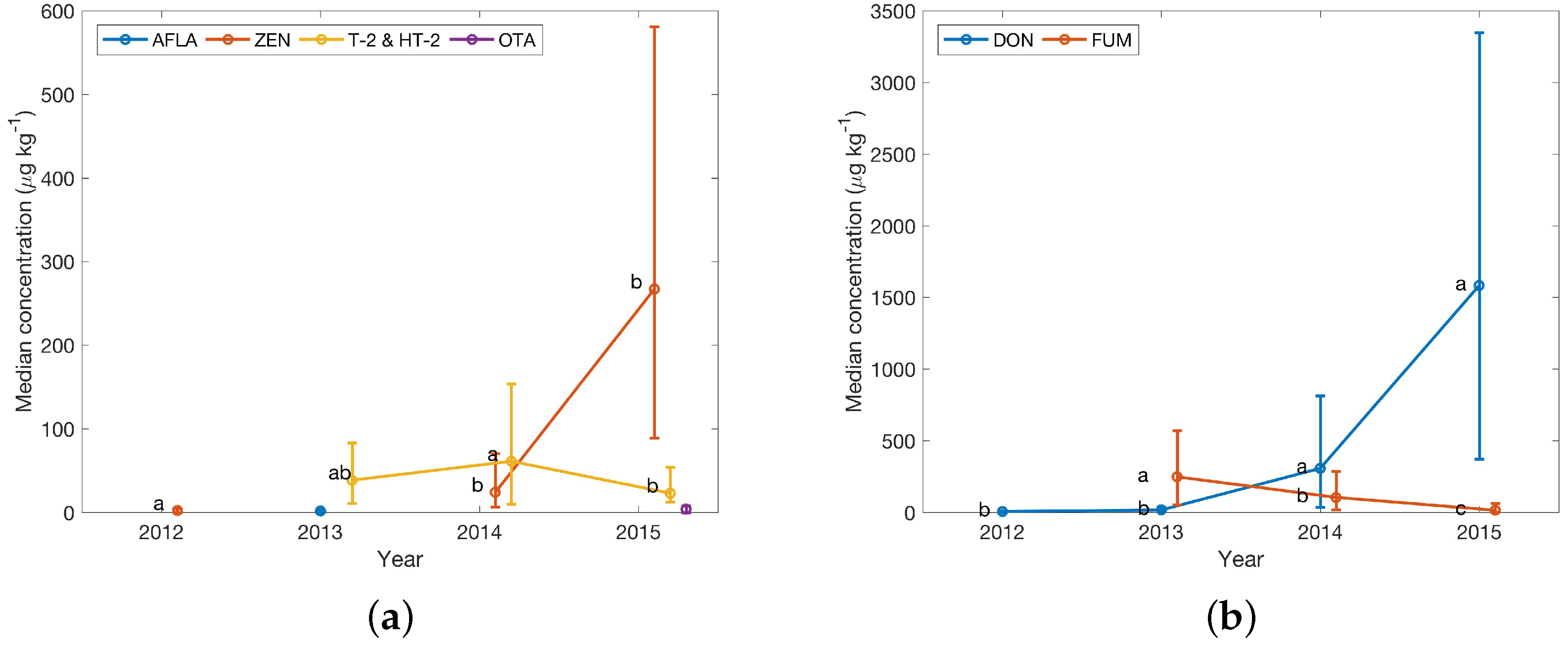

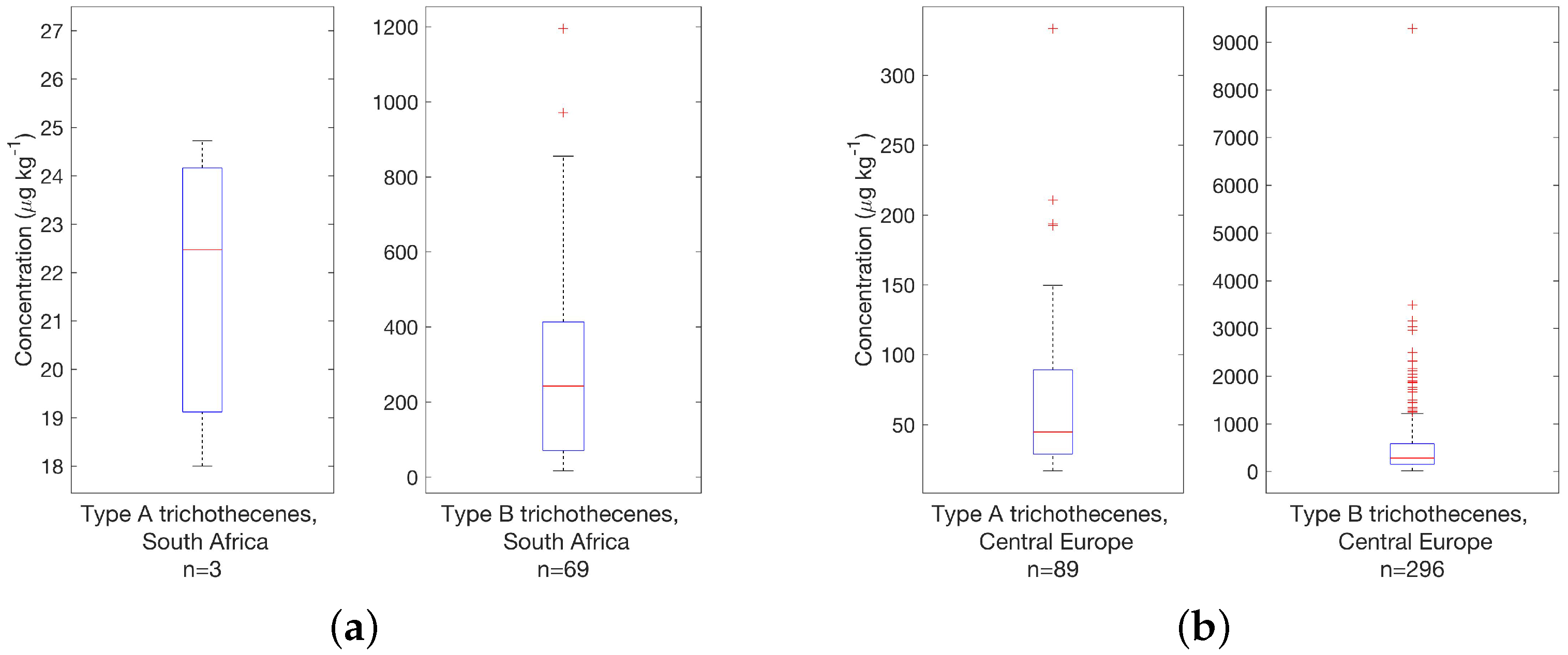

| Metabolite (Group) | Median | 75th | 95th | Maximum | n > t | % > t |
|---|---|---|---|---|---|---|
| Concentration | Percentile | Percentile | Concentration | |||
| (g·kg) | (g·kg) | (g·kg) | (g·kg) | |||
| Regulated toxins and toxins with guidance levels | ||||||
| AFLA, t > 1.5 μg·kg | ||||||
| Aflatoxin B1 | <LOD | <LOD | 1.4 | 1077 | 49 | 4.9 |
| Aflatoxin B2 | <LOD | <LOD | <LOD | 112 | 14 | 1.4 |
| Aflatoxin G1 | <LOD | <LOD | <LOD | 95 | 19 | 1.9 |
| Aflatoxin G2 | <LOD | <LOD | <LOD | 12 | 8 | 0.80 |
| ZEN, t > 1 g·kg | 20 | 77 | 596 | 11,192 | 884 | 88 |
| DON, t > 1.5 g·kg | 193 | 546 | 2278 | 13,488 | 799 | 79 |
| T-2 and HT-2 toxins, t > 10 μg·kg | ||||||
| T-2 toxin | < LOD | 3 | 22 | 852 | 105 | 10 |
| HT-2 toxin | < LOD | 0.0 | 51 | 2328 | 189 | 19 |
| FUM, t > 4.0 μg·kg | ||||||
| Fumonisin B1 | 42 | 248 | 1842 | 31,784 | 678 | 67 |
| Fumonisin B2 | 14 | 84 | 696 | 12,968 | 580 | 58 |
| Fumonisin B3 | < LOD | 34 | 284 | 3345 | 400 | 40 |
| Fumonisin B4 | < LOD | 10 | 192 | 4341 | 284 | 28 |
| Fumonisin B6 | < LOD | < LOD | < LOD | 30 | 1 | 0.10 |
| OTA, t > 1.5 g·kg | < LOD | < LOD | 1.0 | 67 | 45 | 4.5 |
| Masked toxins | ||||||
| DON-3-glucoside, t > 1 g·kg | 12 | 44 | 424 | 3159 | 701 | 70 |
| ZEN-14-sulfate, t > 2 g·kg | 1.3 | 17 | 132 | 4318 | 471 | 47 |
| Emerging toxins | ||||||
| BEA, t > 1.0 g·kg | 8.5 | 25 | 114 | 1610 | 831 | 83 |
| MON, t > 2.0 g·kg | 16 | 61 | 236 | 1367 | 793 | 79 |
| Ergot alkaloids, t > 1.5 μg·kg | ||||||
| Agroclavine | <LOD | <LOD | <LOD | 108 | 37 | 3.7 |
| Chanoclavine | <LOD | 0.053 | 0.76 | 21 | 19 | 1.9 |
| Dihydrolysergol | <LOD | <LOD | <LOD | 5.2 | 2 | 0.20 |
| Elymoclavine | <LOD | <LOD | <LOD | 0.24 | 0 | 0 |
| Ergine | <LOD | <LOD | <LOD | 0.40 | 0 | 0 |
| Ergocornine | <LOD | <LOD | 1.9 | 48 | 56 | 6 |
| Ergocorninine | <LOD | <LOD | 1.8 | 21 | 57 | 5.7 |
| Ergocristine | <LOD | <LOD | 13 | 449 | 114 | 11 |
| Ergocristinine | <LOD | <LOD | 4.3 | 118 | 84 | 8.3 |
| Ergocryptine | <LOD | <LOD | 7.9 | 65 | 101 | 10 |
| Ergocryptinine | <LOD | <LOD | 2.0 | 20 | 66 | 6.6 |
| Ergometrine | <LOD | <LOD | 12 | 405 | 145 | 14 |
| Ergometrinine | <LOD | <LOD | 1.2 | 53 | 41 | 4.1 |
| Ergosine | <LOD | <LOD | 6.5 | 560 | 102 | 10 |
| Ergosinine | <LOD | <LOD | 1.4 | 102 | 49 | 4.9 |
| Ergotamine | <LOD | <LOD | 8.8 | 334 | 89 | 8.8 |
| Ergotaminine | <LOD | <LOD | 1.1 | 65 | 48 | 4.8 |
| Festuclavine | <LOD | <LOD | <LOD | 22 | 7 | 0.70 |
| Enniatins, t > 1.0 μg·kg | ||||||
| Enniatin A | 0.22 | 1.5 | 8.1 | 92 | 319 | 32 |
| Enniatin A1 | 2.0 | 10 | 57 | 481 | 596 | 59 |
| Enniatin B | 5.9 | 29 | 137 | 1514 | 711 | 71 |
| Enniatin B1 | 5.4 | 29 | 145 | 1846 | 693 | 69 |
| Enniatin B2 | <LOD | 0.90 | 4.3 | 98 | 233 | 23 |
| Enniatin B3 | <LOD | 0.010 | 0.070 | 138 | 30 | 3.0 |
| Aflatoxin precursors, t > 4.0 μg·kg | ||||||
| Norsolorinic acid | <LOD | <LOD | <LOD | 24 | 3 | 0.30 |
| Averufin | <LOD | <LOD | 2.2 | 139 | 30 | 3.0 |
| Averufanin | <LOD | <LOD | <LOD | 13 | 2 | 0.20 |
| Versicolorin A | <LOD | <LOD | 0.12 | 15 | 3 | 0.30 |
| Versicolorin C | <LOD | <LOD | 6.1 | 906 | 55 | 5.5 |
| Averantin | <LOD | <LOD | <LOD | 9.1 | 2 | 0.20 |
| Sterigmatocystin | <LOD | <LOD | 1.9 | 6296 | 23 | 2.3 |
| Trichothecenes | ||||||
| Type A trichothecenes, t > 15 μg·kg | ||||||
| (incl. T-2, HT-2 toxins) | ||||||
| Diacetoxyscirpenol | <LOD | <LOD | <LOD | 41 | 2 | 0.20 |
| 15-Monoacetoxyscirpenol | <LOD | <LOD | <LOD | 94 | 7 | 0.70 |
| Neosolaniol | <LOD | <LOD | 2.2 | 125 | 35 | 3.5 |
| T2-Tetraol | <LOD | <LOD | <LOD | 290 | 13 | 1.3 |
| T2-Triol | <LOD | <LOD | <LOD | 93 | 1 | 0.10 |
| Type B trichothecenes, t > 15 μg·kg | ||||||
| (incl. DON, DON-3-glucoside) | ||||||
| 15-Acetyldeoxynivalenol | <LOD | <LOD | 178 | 2177 | 128 | 13 |
| 3-Acetyldeoxynivalenol | <LOD | <LOD | 24 | 527 | 71 | 7.1 |
| Nivalenol | 4.7 | 18 | 127 | 11,232 | 286 | 28 |
| Region, Country | Matrix | Year(s) | Toxin | Method | Reference |
|---|---|---|---|---|---|
| Global | Feed and ingredients | 2004–2013 | REG | HPLC, Elisa | [56] |
| Europe, Asia | Feed and ingredients | 2004–2011 | REG | HPLC, Elisa | [57] |
| Global | Feed and ingredients | 2004–2012 | REG | HPLC, Elisa | [62] |
| Americas, Europe, | Corn, wheat, | 2009–2011 | REG | HPLC, Elisa | [58] |
| Asia | SBM, DDGS | ||||
| Middle East, Africa | Feed and ingredients | 2009 | REG, A&B | HPLC–FLD, LC–MS | [64] |
| Finland, Sweden, | Cereal grains | 1989–2009 | REG, NIV, | NA | [63] |
| Norway, The Netherlands | 3-Ac-DON | ||||
| Belgium | Oats, pig/poultry feed | 2012 | FUS | LC–MS/MS | [65] |
| China | Dairy cow feed | 2010 | AFLA | HPLC–FLD | [66] |
| The Netherlands | Maize | 2010 | REG, FUS | LC–MS/MS | [67] |
| Pakistan | Poultry feed | 2009–2010 | AFB1 | TLC | [68] |
| USA | DDGS | 2009–2011 | REG | HPLC–FLD, TLC | [69] |
| Portugal | Pig and poultry feed | 2009–2010 | OTA | HPLC–FLD | [70] |
| Argentina | Poultry feed | 2008–2009 | REG, DAS | LC–MS/MS | [71] |
| South Africa | Compound feeds | 2010 | REG | LC–MS/MS | [72] |
| Romania | Cereals | 2008–2010 | REG | Elisa | [73] |
| Serbia | Wheat | 2007 | FUS | LC–MS/MS | [74] |
| China | Feed and ingredients | 2008–2009 | REG | LC–MS | [75] |
| Region/Country | Compound | 2012 | 2013 | 2014 | 2015 |
|---|---|---|---|---|---|
| Central Europe | |||||
| AFLA | NA | NA | NA | 4 | |
| ZEN | 21 | 20 | 124 | 153 | |
| T-2 & HT-2 | 2 | 7 | 57 | 22 | |
| DON | 21 | 25 | 123 | 129 | |
| FUM | 6 | 11 | 72 | 94 | |
| OTA | NA | NA | 2 | 5 | |
| Ergots | 3 | 21 | 84 | 53 | |
| Enniatins | 21 | 25 | 128 | 157 | |
| PreAflas | NA | NA | 13 | 32 | |
| MON | 21 | 19 | 105 | 114 | |
| BEA | 17 | 17 | 98 | 102 | |
| DON-3-glucoside | 20 | 14 | 100 | 121 | |
| ZEN-14-sulfate | 2 | 5 | 76 | 92 | |
| Austria | |||||
| AFLA | NA | NA | NA | NA | |
| ZEN | NA | NA | 34 | 24 | |
| T-2 & HT-2 | NA | 4 | 24 | 3 | |
| DON | NA | 4 | 32 | 22 | |
| FUM | NA | 4 | 24 | 12 | |
| OTA | NA | NA | NA | NA | |
| Germany | |||||
| AFLA | NA | NA | NA | NA | |
| ZEN | NA | 15 | 35 | 33 | |
| T-2 & HT-2 | NA | NA | 8 | 9 | |
| DON | NA | 15 | 36 | 32 | |
| FUM | NA | 4 | 17 | 14 | |
| OTA | NA | NA | NA | NA | |
| Italy | |||||
| AFLA | NA | NA | NA | NA | |
| ZEN | 2 | 5 | 13 | 34 | |
| T-2 & HT-2 | NA | NA | 4 | 4 | |
| DON | 2 | 4 | 12 | 32 | |
| FUM | 2 | 4 | 13 | 30 | |
| OTA | NA | NA | NA | NA | |
| The Netherlands | |||||
| AFLA | NA | NA | NA | 4 | |
| ZEN | NA | 2 | 21 | 15 | |
| T-2 & HT-2 | NA | NA | 7 | NA | |
| DON | NA | 2 | 20 | 13 | |
| FUM | NA | NA | 17 | 12 | |
| OTA | NA | NA | NA | NA |
| Region/Toxins | Co-Occurrence | M (%) | MSI (%) | Correlation |
|---|---|---|---|---|
| FF (%) | Compounds (Matrix, ) | |||
| Africa | ||||
| Regulated | 100 | AFLA & AFLA precursors (FF, 0.93) | ||
| ZEN & Enniatins (FF, 0.54) | ||||
| DON & DON-3-glucoside (FF, 0.51) | ||||
| Masked | 92 | |||
| Emerging | 100 | |||
| South Africa | ||||
| Regulated | 90 | 59 | AFLA & AFLA precursors (M, 0.69) | |
| AFLA & BEA (M, 0.77) | ||||
| DON & DON-3-glucoside (M, 0.76) | ||||
| ZEN & ZEN-14-sulfate (M, 0.65) | ||||
| Masked | 50 | 28 | ||
| Emerging | 90 | 36 | ||
| Central Europe | ||||
| Regulated | 73 | 56 | 54 | DON & DON-3-glucoside (FF, 0.57) |
| DON & DON-3-glucoside (M, 0.80) | ||||
| ZEN & ZEN-14-sulfate (M, 0.56) | ||||
| DON & DON-3-glucoside (MSI, 0.77) | ||||
| ZEN & ZEN-14-sulfate (MSI, 0.79) | ||||
| Masked | 57 | 72 | 44 | |
| Emerging | 93 | 83 | 83 | |
| Eastern Europe | ||||
| Regulated | 74 | (H)T-2 & DON-3-glucoside (FF, 0.50) | ||
| DON & DON-3-glucoside (FF, 0.81) | ||||
| ZEN & ZEN-14-sulfate (FF, 0.76) | ||||
| (H)T-2 & BEA (FF, 0.57) | ||||
| Masked | 22 | |||
| Emerging | 91 | |||
| Northern Europe | ||||
| Regulated | 45 | DON & DON-3-glucoside (FF, 0.58) | ||
| ZEN & ZEN-14-sulfate (FF, 0.65) | ||||
| Masked | 47 | |||
| Emerging | 82 | |||
| Southern Europe | ||||
| Regulated | 89 | DON & DON-3-glucoside (FF, 0.63) | ||
| Masked | 73 | |||
| Emerging | 96 | |||
| Middle East | ||||
| Regulated | 93 | DON & DON-3-glucoside (FF, 0.50) | ||
| FUM & MON (FF, 0.51) | ||||
| Masked | 91 | |||
| Emerging | 95 | |||
| North America | ||||
| Regulated | 88 | 63 | DON & DON-3-glucoside (FF, 0.50) | |
| ZEN & ZEN-14-sulfate (FF, 0.81) | ||||
| Masked | 52 | 40 | ||
| Emerging | 100 | 77 | ||
| South America | ||||
| Regulated | 54 | AFLA & AFLA precursors (M, 0.98) | ||
| DON & DON-3-glucoside (M, 0.76) | ||||
| ZEN & ZEN-14-sulfate (M, 0.93) | ||||
| DON & MON (M, 0.56) | ||||
| ZEN & MON (M, 0.64) | ||||
| Masked | 21 | |||
| Emerging | 71 |
| (a) | Number of Metabolites | ||
| All 1926 Samples, | All Matrices | ||
| 380 compounds measured, | |||
| 162 quantified | |||
| Max. no. of compounds per sample | 68 | ||
| Compounds in samples, conc. >1 g·kg | 59 | ||
| Av. no. of compounds in all samples | 28 | ||
| Av. no. of compounds, conc. >1 g·kg | 24 | ||
| Number of metabolites | |||
| Subset 1113 samples, | Finished feed | Maize | Maize silage |
| 57 metabolites quantified | |||
| Max. no. of compounds per sample | 35 | 29 | 28 |
| Compounds in samples, conc. >1 g·kg | 31 | 26 | 20 |
| Av. no. of compounds in all samples | 16 | 12 | 11 |
| Av. no. of compounds, conc. >1 g·kg | 13 | 10 | 9 |
| (b) | Number of Samples | ||
| Finished Feed | Maize | Maize Silage | |
| Region subsets | |||
| All samples | 708 | 267 | 138 |
| Africa | 24 | 7 | 1 |
| South Africa | 74 | 53 | 28 |
| Central Europe | 335 | 76 | 78 |
| Eastern Europe | 45 | 9 | 1 |
| Northern Europe | 68 | 4 | 12 |
| Southern Europe | 90 | 11 | 2 |
| Middle East | 23 | 0 | 0 |
| North America | 27 | 30 | 15 |
| South America | 22 | 77 | 1 |
| Country subsets | |||
| Austria | 64 | 18 | 26 |
| Germany | 89 | 32 | 38 |
| Hungary | 67 | 2 | 3 |
| Italy | 53 | 2 | 2 |
| The Netherlands | 40 | 7 | 9 |
| (c) Countries in region (total of 46) | |||
| Africa: Algeria, Ivory Coast, Kenya, Senegal, Tunisia, Tanzania, Uganda, Zambia | |||
| South Africa: South Africa | |||
| Central Europe: Austria, Belgium, Czech Republic, France, Germany, Hungary, The Netherlands, Poland, | |||
| Romania, Switzerland | |||
| Eastern Europe: Bulgaria, Russia, Ukraine | |||
| Northern Europe: Denmark, Finland, Iceland, Ireland, Norway, Sweden, United Kingdom | |||
| Southern Europe: Croatia, Italy, Spain, Portugal, Turkey | |||
| Middle East: Israel, Jordan | |||
| North America: United States, Canada | |||
| South America: Argentina, Brazil, Bolivia, Chile, Colombia, Ecuador, Paraguay, Peru | |||
© 2016 by the authors; licensee MDPI, Basel, Switzerland. This article is an open access article distributed under the terms and conditions of the Creative Commons Attribution (CC-BY) license (http://creativecommons.org/licenses/by/4.0/).
Share and Cite
Kovalsky, P.; Kos, G.; Nährer, K.; Schwab, C.; Jenkins, T.; Schatzmayr, G.; Sulyok, M.; Krska, R. Co-Occurrence of Regulated, Masked and Emerging Mycotoxins and Secondary Metabolites in Finished Feed and Maize—An Extensive Survey. Toxins 2016, 8, 363. https://doi.org/10.3390/toxins8120363
Kovalsky P, Kos G, Nährer K, Schwab C, Jenkins T, Schatzmayr G, Sulyok M, Krska R. Co-Occurrence of Regulated, Masked and Emerging Mycotoxins and Secondary Metabolites in Finished Feed and Maize—An Extensive Survey. Toxins. 2016; 8(12):363. https://doi.org/10.3390/toxins8120363
Chicago/Turabian StyleKovalsky, Paula, Gregor Kos, Karin Nährer, Christina Schwab, Timothy Jenkins, Gerd Schatzmayr, Michael Sulyok, and Rudolf Krska. 2016. "Co-Occurrence of Regulated, Masked and Emerging Mycotoxins and Secondary Metabolites in Finished Feed and Maize—An Extensive Survey" Toxins 8, no. 12: 363. https://doi.org/10.3390/toxins8120363






